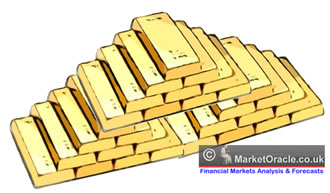Latest on U.S. Interest Rates, the Fed and Asset Price Inflation
Stock-Markets / Liquidity Bubble Nov 13, 2009 - 07:56 AM GMTBy: Mike_Larson
 When it comes to Lay’s potato chips, the saying goes, you can’t eat just one.
When it comes to Lay’s potato chips, the saying goes, you can’t eat just one.
And when it comes to the interest rate and financial markets, I just can’t focus on one thing this week. There’s just too much going on.
So if you’ll forgive me, I’m going to cover a lot of ground in the little time I have. Fasten your seatbelt!
Fed Still … STILL … Doesn’t Get It When It Comes to Asset Bubbles
More than a year and a half ago, right here in Money and Markets, I took the Federal Reserve to task for one of its idiotic practices — its approach to asset bubbles. My view back then:
 |
| The Fed continues inflating one asset bubble after another. |
“The Federal Reserve has this asinine policy of ignoring asset bubbles as they inflate. Policymakers claim that’s because they shouldn’t substitute their judgment for the market’s, and that it’s impossible to identify bubbles except in hindsight anyway.
“The better solution — in their view — is to come in and try to mop up the aftermath by slashing rates and taking other steps.
“But that’s just nuts!”
Clearly, events have proven me right — and the Fed wrong.
Officials didn’t raise margin requirements to stem the asset bubble in stocks in the 1990s. That allowed the equity bubble to expand dramatically. Then Alan Greenspan slashed rates in the wake of the Long-Term Capital Management blow up in 1998 … and flooded banks with reserves to offset what turned out to be a Y2K nonevent. These moves helped turbocharge the markets, leading to the final, climatic blow off in the Nasdaq.
Then in attempting to “mop up” that bust, policymakers drove rates into the gutter and left them there for far too long. They also refused to take any proactive regulatory steps to tamp down mortgage market excesses, or even use the bully pulpit in an attempt to prevent the housing market from overinflating. Result: The biggest housing bubble and bust in the history of the U.S.
And yet … and YET … former Fed governor Frederic Mishkin had the nerve to write this week in the Financial Times that the Fed shouldn’t tweak policy to fight asset bubbles. An excerpt:
“There is increasing concern that we may be experiencing another round of asset-price bubbles that could pose great danger to the economy. Does this danger provide a case for the US Federal Reserve to exit from its zero-interest-rate policy sooner rather than later, as many commentators have suggested? The answer is no.”
My response: Is Mishkin joking? Can he seriously still maintain that “mopping up” after busts with liberal helpings of cheap money is the best policy approach? I surely hope that SITTING governors at the Fed don’t believe that claptrap.
I can’t help but point out, while I’m at it, that Mishkin is one of the geniuses at the Fed who never saw a problem with the housing and mortgage bubbles in the first place. In a now-infamous speech in January 2007, he said the Fed should ignore housing bubbles when it comes to setting policy. The money quote that shows just how thoroughly discredited Mishkin should be:
“There are even stronger reasons to believe that a bursting of a bubble in house prices is unlikely to produce financial instability. House prices are far less volatile than stock prices, outright declines after a run-up are not the norm, and declines that do occur are typically relatively small … Hence, declines in home prices are far less likely to cause losses to financial institutions, default rates on residential mortgages typically are low, and recovery rates on foreclosures are high. Not surprisingly, declines in home prices generally have not led to financial instability.”
I rest my case.
Inflation Worries … Who Cares?
Speaking of the Fed, its primary job has always been (in theory) to tamp down inflation. One of its supposed inflation “signals” is the TIPS spread, or the difference in yield between nominal Treasuries and Treasury Inflation Protected Securities. The wider that spread, the greater the fear of inflation among bond investors.
Ahead of the most recent Fed meeting, there was a lot of chatter that officials might take a tougher line on inflation. But as I described in last week’s column, they didn’t take the bait. Instead, Ben Bernanke and Co. reiterated that rates would remain low for roughly forever.
 |
| Gold shot past the $1,100 mark — another sign that investors are worried about inflation. |
Other policymakers have since gotten in front of the microphone and reiterated the same message …
Dallas Fed President Richard Fisher said Tuesday that “current policy is appropriate” in light of “suboptimal” growth and “vexing” unemployment. San Francisco Fed President Janet Yellen added that “we need to provide the monetary accommodation necessary to spur job creation and prevent inflation from falling any further below rates that are consistent with price stability.”
Result: The 10-year TIPS spread blew out to 223 basis points, or 2.23 percentage points. That’s the widest in almost 16 months, and a clear sign that bond investors are getting unnerved about inflation risk.
Meanwhile, the spread between yields on 2-year Treasury Notes and 30-year Treasury bonds just hit 359 basis points. That’s just 6 bps shy of the highest level in modern history (my data goes back to 1980; the previous high was in 1992).
A steep yield curve is yet another indicator of inflation fears. It shows that long-term bond buyers are demanding a hefty interest rate premium to compensate them for the risk of higher prices down the road.
And you don’t need me to tell you what the gold market is shouting from the rooftops. Gold prices just vaulted above $1,100 an ounce, the highest nominal price in U.S. history.
Hello? Anyone at the Fed listening?
Dollar Non-Defense Continues …
Then there’s the ongoing non-defense of the dollar from policymakers both here and abroad. The G-20 gathering in Scotland last weekend contained no dollar-supportive talk. If anything, Treasury Secretary Tim Geithner helped kick the stool out from under the buck, declaring that “it’s too early to lean against the recovery.” That’s code-speak for “We’ll continue our easy money policies in place.”
 |
| The Fed continues to let your dollars shrink. |
Heck, an IMF report that was released in conjunction with the gathering suggests the dollar carry trade will likely continue. Why? Because the buck is still overvalued.
At some point, interest rate dynamics will change and the U.S. dollar will stop becoming the world’s plaything for leveraged carry trades. But the fact of the matter is, borrowing dollars is STILL cheaper than borrowing virtually any other currency on the planet.
Three-month dollar LIBOR rates were as low as 0.27 percent this week. That’s less than the 0.32 percent cost of borrowing Japanese yen … the 0.61 percent rate to borrow money in pounds sterling … and the 0.68 percent rate for euro-based loans.
The common theme tying all these stories together — and the lessons for individual investors? Simple …
- The Fed doesn’t care about the devaluation of your dollars. Policy will remain too easy for too long.
- Inflation pressures will build, especially in the “financial/asset” economy (as opposed to the “real” economy).
Until next time,
Mike
This investment news is brought to you by Money and Markets . Money and Markets is a free daily investment newsletter from Martin D. Weiss and Weiss Research analysts offering the latest investing news and financial insights for the stock market, including tips and advice on investing in gold, energy and oil. Dr. Weiss is a leader in the fields of investing, interest rates, financial safety and economic forecasting. To view archives or subscribe, visit http://www.moneyandmarkets.com .
© 2005-2022 http://www.MarketOracle.co.uk - The Market Oracle is a FREE Daily Financial Markets Analysis & Forecasting online publication.



